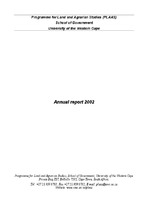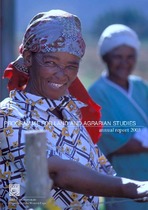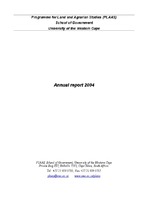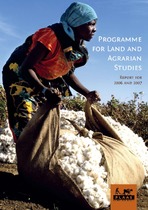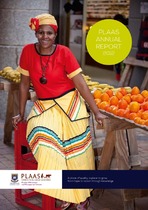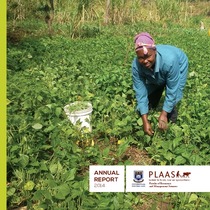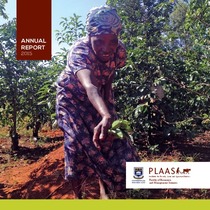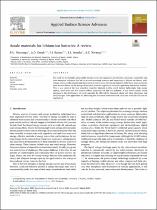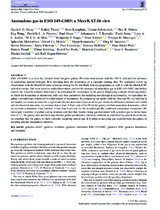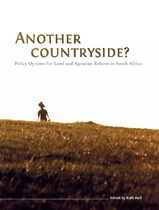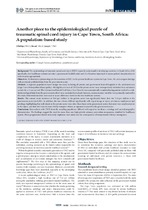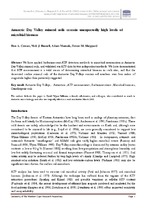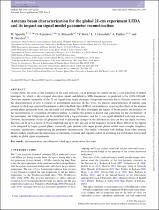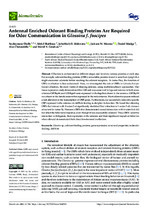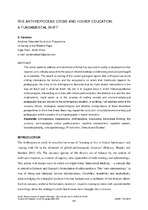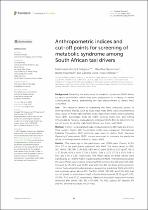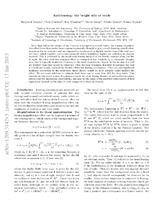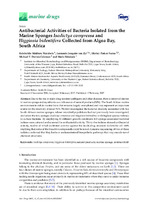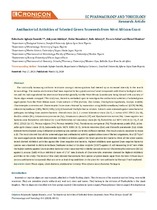Browsing by Title
Now showing items 302-321 of 7879
-
Annual report 2002
(Institute for Poverty Land and Agrarian Studies (PLAAS), 2003)The year 2002 was an extremely busy one for PLAAS staff, and saw the initiation of many new projects and activities, some of them qualitatively different to anything undertaken before. These included an in-depth, national ... -
Annual report 2003
(Institute for Poverty Land and Agrarian Studies (PLAAS), 2004)Applied social science researchers generally want to see their research influence policy and practice; those of a more activist bent seek to ‘change the world, not simply to interpret it’.1 In its mission statement ... -
Annual report 2004
(Institute for Poverty Land and Agrarian Studies (PLAAS), 2005)The wider context of our research and training, and the ultimate rationale for establishing and maintaining a centre such as PLAAS, is the key challenge of deeply entrenched poverty, as well as the inequality to which ... -
Annual report 2006-2007
(Institute for Poverty Land and Agrarian Studies (PLAAS), 2008)Over the past two years the contradictions inherent in South Africa’s post-apartheid growth and development path have become increasingly evident. Growth has not managed to reduce very high levels of unemployment to a ... -
Annual report 2012
(Institute for Poverty Land and Agrarian Studies (PLAAS), 2013)In much of the global South the instability in global financial systems continued to have dire effects – and there were many worrying signs that the serious food price inflation the world experienced in 2008 would return. ... -
Annual report 2014
(Institute for Poverty Land and Agrarian Studies (PLAAS), 2015)Very often, in our work at PLAAS, we encounter two common misunderstandings about what it is that we do and why it is important. One common misunderstanding is that we are some sort of technical agricultural education ... -
Annual report 2015
(Institute for Poverty Land and Agrarian Studies (PLAAS), 2016)The year 2015 was a momentous one for PLAAS. It marked twenty years since the day that PLAAS started off as an organisation with some generous start-up funding from the Ford Foundation. PLAAS started life small: initially ... -
Anode materials for lithium-ion batteries: A review
(Elsevier, 2022)The need for eco-friendly and portable energy sources for application in electrical, electronic, automobile and even aerospace industries has led to an ever-increasing research and innovation in lithium-ion battery technology. ... -
Anomalous gas in ESO 149-G003: A MeerKAT-16 view
(Oxford University Press, 2021)ESO 149-G003 is a close-by, isolated dwarf irregular galaxy. Previous observations with the ATCA indicated the presence of anomalous neutral hydrogen (H I) deviating from the kinematics of a regularly rotating disc. We ... -
Another countryside? Policy options for land and agrarian reform in South Africa
(Institute for Poverty, Land and Agrarian Studies, University of the Western Cape, 2009)Land reform in South Africa is a political project that has foundered. For years, the process has been variously described as being ‘in crisis’, ‘at a crossroads’, ‘at an impasse’ or simply ’stuck’. This still seems as ... -
Another countryside? Policy options for land and agrarian reform in South Africa
(Institute for Poverty Land and Agrarian Studies (PLAAS), 2009)Land reform in South Africa is a political project that has foundered. For years, the process has been variously described as being ‘in crisis’, ‘at a crossroads’, ‘at an impasse’ or simply ’stuck’. This still seems as ... -
Another piece to the epidemiological puzzle of traumatic spinal cord injury in Cape Town, South Africa: A population-based study2018
(Health and Medical Publishing Group, 2018)The epidemiology of traumatic spinal cord injury (TSCI) is poorly understood in developing countries. In South Africa (SA) specifically, two healthcare systems (private v. government funded) exist, and it is therefore ... -
Antarctic Dry Valley mineral soils contain unexpectedly high levels of microbial biomass
(Springer Verlag, 2002)We have applied bioluminescent ATP detection methods to microbial enumeration in Antarctic Dry Valley mineral soils, and validated our ATP data by two independent methods. We have demonstrated that ATP measurement is ... -
Antenna beam characterization for the global 21-cm experiment LEDA and its impact on signal model parameter reconstruction
(Oxford University Press, 2022)Cosmic dawn, the onset of star formation in the early universe, can in principle be studied via the 21-cm transition of neutral hydrogen, for which a sky-averaged absorption signal, redshifted to MHz frequencies, is predicted ... -
Antennal enriched odorant binding proteins are required for odor communication in glossina f. Fuscipes
(MPDI, 2021)Olfaction is orchestrated at different stages and involves various proteins at each step. For example, odorant-binding proteins (OBPs) are soluble proteins found in sensillum lymph that might encounter odorants before ... -
The Anthropocene crisis and higher education: A fundamental shift
(South African Association for Research and Development in Higher Education (SAARDHE), 2016)This article seeks to address a fundamental shift that has occurred in reality; a displacement that requires us to critically account for the ways in which knowledge is both being produced and taught at universities. The ... -
Anthropometric indices and cut-off points for screening of metabolic syndrome among South African taxi drivers
(Frontiers Media, 2022)Detecting the early onset of metabolic syndrome (MetS) allows for quick intervention which may slow progression to a variety of health consequences, hence, determining the best measurement to detect MetS is essential. ... -
Anti-lensing: the bright side of voids
(American Physical Society, 2013)More than half of the volume of our Universe is occupied by cosmic voids. The lensing magni ca- tion e ect from those under-dense regions is generally thought to give a small dimming contribution: objects on the far side ... -
Antibacterial activities of bacteria isolated from the marine sponges Isodictya compressa and Higginsia bidentifera collected from Algoa Bay, South Africa
(MDPI AG, 2017)Due to the rise inmulti-drug resistant pathogens and other diseases, there is renewed interest in marine sponge endosymbionts as a rich source of natural products (NPs). The South African marine environment is rich in ... -
Antibacterial Activities of Selected Green Seaweeds from West African Coast
(EC Pharmacology and Toxicology ECronicon Open Access, 2020)The continually increasing antibiotic resistance amongst microorganisms had steered up an increased intensity in the search for new drugs. The marine environment had been reported to be a great source of novel compounds ...

